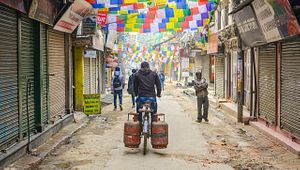Four years ago, celebrations erupted across the Nepali capital after President Ram Baran Yadav stood in front of the Constituent Assembly and promulgated a new constitution. The constitution formally declared Nepal a federal democratic republic and was the product of the second Constituent Assembly which had been in session since 2013. The final proceedings of the constitution were fast tracked in an ephemeral moment of political unity as the country still reeled from the devastating April earthquakes earlier the same year.
New constitutions were introduced in Nepal in 1948, 1951, 1959, 1962, 1990, 2007 and 2015. Each edition indicated a change in the political outlook of Nepalis and a demand for change of the status quo to varying degrees. The 2015 Constitution of Nepal sought to, at least in spirit, usher in Naya Nepal (New Nepal), a Nepal that brought equality to all Nepalis. Today’s 30-year-old Nepalis would have been born into a system of Panchayat (a party-less system), where Nepal was the world’s last Hindu kingdom, run by an absolute monarch. Now with the new constitution, Nepal became a federal secular republic with representative democracy. Its monarchy, which had reigned since 1768, was abolished in 2008.
All is Not Well
Yet the celebrations that accompanied the constitution in Kathmandu, supposed to bring in a new era of unity and domestic harmony in the country and direct Nepal on the road to a more inclusive state, only served to illustrate the fundamental differences between the different ethnic groups that make up Nepal. The constitution was bitterly opposed in the southern plains adjoining India with protests which left at least 45 dead (including civilians and security personnel). That a document brought a sense of unity in the hills, yet signified the same old division in the plains, is indicative of the scale of the issue the Nepali state needs to deal with.
The 2015 Constitution of Nepal failed to address the demands of Madhesi and indigenous populations, particularly concerns regarding the drawing of federal boundaries. Most contentious of all was the citizenship criteria indicative of the two tiered legal system on offer. This criteria, which was discriminatory against Madhesis and women and made it very difficult for both women and Madeshis to pass on citizenship to their children. The fact that what was otherwise such a progressive and reformist constitution, which brought monumental changes in the country’s legislature, governance and administration would retain outdated citizenship requirements was surprisingly conservative. Yet displeasure at the constitution was not just limited to inside the country, as India soon sought to justify a blockade of Nepal’s borders in protest.
Why Did the Constitution Divide Nepal?
Those defending the constitution and its overzealous citizenship requirements point to an open and highly porous border with India and the need to safeguard state sovereignty. Yet ill-considered fears of a mass influx of Indian migrants clamoring for Nepali citizenship should not be allowed to close off avenues to Nepali citizenship and access to the many benefits of the State that comes with it. After all there are many marginalized communities in Nepal which for a myriad of reasons have been unable to secure citizenship or documentation to this day.
Today, while for some Constitution Day is a celebration of the ending of the final restructuring required after the civil war and is a marker of the progress Nepal has made since the signing of the Comprehensive Peace Agreement in 2006, for others celebrations in the face of complaints signify how far there is to go to achieve a fair and equitable Nepal. Lawmakers and policymakers should not confuse a quiet Terai for a placated one. Just because the Terai is no longer aflame does not mean the concerns of such communities have gone away.
Indeed, this is immensely important as in the long run, there are few issues facing Nepal that may be more problematic than citizenship and the wider question around Nepali identity, which is itself directly related to the (indirect) restrictive citizenship requirements in the constitution for Madhesis.
What Options For Constitutional Reform Does Nepal Have?
Conservatives, in the name of national security, have not been inclined toward inclusion and measures they have taken have made it difficult for the non-Nepali spouse of a Nepali woman to acquire citizenship, fearing that masses of Indian men will populate and take up important positions in Nepal. But conservatives need to seriously contemplate the question if being non-inclusive is a good security strategy in the long run? In short, is it a good security policy to alienate the Madhesis through the introduction of such stringent citizenship criteria? With the parliamentary deliberations on Citizenship Amendment Bill almost concluded, already there are fears that scores of Madhesis will be back on the streets, demanding not to be shunned aside (again).
For those committed to a socially progressive inclusive Nepal, there needs to be deliberate efforts made to incorporate the Madhesis and other marginalized communities into the popularly envisaged national identity of Nepal and this cannot happen without a reconciled approach to the countries citizenship restrictions to ensure that such communities are brought into both the Nepali State, through avenues to citizenship, and the Nepali Nation. To operationalize the constitution, many scores of acts are being enacted and existing ones amended. There may be no better time than now to consider Madhesi sensitivities. Doing so will require deliberate action to expand the Nepali identity umbrella beyond “Ek bhasa, ek bhusa (one national language and attire).”
Nirnaya Bhatta is a graduate from the Lee Kuan Yew School of Public Policy in Singapore, and he completed a Graduate Programme in International Relations from the University of Warsaw, Poland in 2014.
Maximillian Morch is a researcher, author and Human Rights Officer at Assistance Association of Political Prisoners Burma.

































